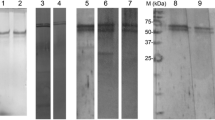Abstract
Ten antisera raised in rabbits, against polymeric flagellins from ten differentSalmonella serotypes were used to determine the relative cross-activities between salmonella flagellins in monomeric form. The results showed a high degree of cross-reactivity between the antisera (IgG antibodies) and all monomeric flagellins investigated. Consequently, it was possible to detect the tenSalmonella serotypes, after heat depolymerization of flagella using radioimmunometric assay with only one antiserum raised against polymeric flagellin from one serotype. The results also showed that native flagella differed antigenically from repolymerized and monomeric flagellins. This is possibly due to changes in the tertiary structure of sub-units of flagella when depolymerized with acid or heat resulting in unfolding and unmasking of common antigenic determinants. The unfolded and unmasked antigenic determinants were not only common to theSalmonella serotypes investigated, but also to other members of Enterobacteriaceae.
Similar content being viewed by others
References
Austin CM, Nossal GJV (1966) Mechanism of induction of immunological tolerance. III. Cross-tolerance amongst flagellar antigens. Aust J Exp Biol Med Sci 44:341–354
Collins WS, Johnson AD, Metzger JF, Bennett RW (1973) Rapid solid-phase radio-immunoassay for staphylococcal enterotoxin A. Appl Microbiol 25:774–777
Doetsch RN, Sjoblad RD (1980) Flagellar structure and function in eubacteria. Ann Rev Microbiol 34:69–108
Erlanger BF, Beiser SM, Borek F, Edel F, Lieberman S (1967) Methods in immunology and immunochemistry, ed. Williams CA, Chase MW, Academic Press, New York, Vol. 1, p 148
Greenwood FC, Hunter WM, Glover JS (1963) The preparation of131I-labelled human growth hormone of high specific radioactivity. Biochem J 89:114–123
Gupta RK, Morton DL (1979) Double-antibody method and the protein-A-bearingStaphylococcus aureus cells method compared for separating bound and free antigen in radioimmunoassay. Clin Chem 25:752–756
Ibrahim GF (1984) Development of immunoassay systems for the detection ofSalmonella in foods. Ph.D. Thesis, University of New South Wales, Kensington, N.S.W., Australia, pp 81–93
Ibrahim GF, Radford HM, Fell LR (1980) Determination of staphylococcal enterotoxin A in cheddar cheese produced without starter activity. Appl Environ Microbiol 39: 1134–1137
Ibrahim GF, Fleet GH, Lyons MJ, Walker RA (1985) Immunological relationships betweenSalmonella flagella and their potential application for salmonellae detection by immunoassay. Med Microbiol Immunol (in press)
Kauffman PE, Johnson HM (1975) Stability of125I-labelled staphylococcal enterotoxins in solid-phase radioimmunoassay. Appl Microbiol 29:776–779
Koffler H, Mallett GE, Adye J (1957) Molecular basis of biological stability to high temperatures. Proc Natl Acad Sci 43:464–477
Langman RE (1972) The occurrence of antigenic determinants common to flagella of differentSalmonella strains. Eur J Immunol 2:582–586
Maciejko JJ, Mao SJ (1982) Radioimmunoassay of apolipoprotein A-1. Application of a non-ionic detergent (tween-20) and solid-phase staphylococcus. Clin Chem 28: 199–204
Martinez RJ, Roscenberg E (1964) Thermal transition ofSpirillum serpens flagella. J Mol Biol 8:702–707
Natali PG, Pellegrino MA, Walker L, Ferrone S, Reisfield RA (1979) Antibody coated protein A-bearingStaphylococcus aureus: A versatile and stable immune reagent. J Immunol Methods 25:255–264
Nossal GJV, Ada GL, Austin CM (1964) Antigens in immunity. II. Immunogenic properties of flagella, polymerized flagellin and flagellin in the primary response. Aust J Exp Biol Med Sci 42:283–294
O'Keefe E, Bennett V (1980) Use of immunoglobulin-loaded protein A-bearing staphylococci as a primary solid phase immunoadsorbent in radioimmunoassay. J Biol Chem 255:561–568
Oliver JR, Hakendorf P, Zeegers P, Ross W (1982) A proposed simple method for the detection and measurement of antibodies to insulin in serum by use ofStaphylococcus aureus containing protein A. Alin Chem 28:121–123
Orth DS (1977) Iodination of staphylococcal enterotoxin B by use of chloramine-T. Appl Environ Microbiol 33:824–828
Parish CR (1971) Immune response to chemically modified flagellin. II. Evidence for a fundamental relationship between humoral and cell-mediated immunity. J Exp Med 134:21–47
Pye J (1968) Antigenic determinants common to bacterial flagellins. Aust Biochem Soc Proc 1:83
Sela M (1969) Antigenicity: Some molecular aspects. Science 166:1365–1374
Smith AM, Potter M (1976) A BALB/c mouse IgA myeloma protein that bindsSalmonella flagellar protein. J Immunol 114:1847–1850
Smith AM, Miller JS, Whitehead DS (1979) M467: A murine IgA myeloma protein that binds a bacterial protein I. Recognition of common antigenic determinants onSalmonella flagellins. J Immunol 123:1715–1720
Vegotsky A, Lim F, Foster JF, Koffler H (1965) Disintegration of flagella by acid. Arch Biochem Biophys 111:296–307
Venning MM (1974) Cellular and humoral responses to bacterial flagellin. Ph.D. thesis. Australian National University, Canberra, Australia, pp 55–60
Wistar R, Jr (1968) Serum antibody toSalmonella flagellar antigens. I. Methods of antibody assay. Aust J Exp Biol Med Sci 46:769–777
Ying SY, Guillemin R (1979) DriedStaphylococcus aureus as a rapid immunological separating agent in radioimmunoassays. J Clin Endocrinol Metab 48:360–362
Author information
Authors and Affiliations
Rights and permissions
About this article
Cite this article
Ibrahim, G.F., Fleet, G.H., Lyons, M.J. et al. Immunological relationships betweenSalmonella flagellins and between these and flagellins from other species of Enterobacteriaceae. Med Microbiol Immunol 174, 101–113 (1985). https://doi.org/10.1007/BF02123231
Received:
Issue Date:
DOI: https://doi.org/10.1007/BF02123231




